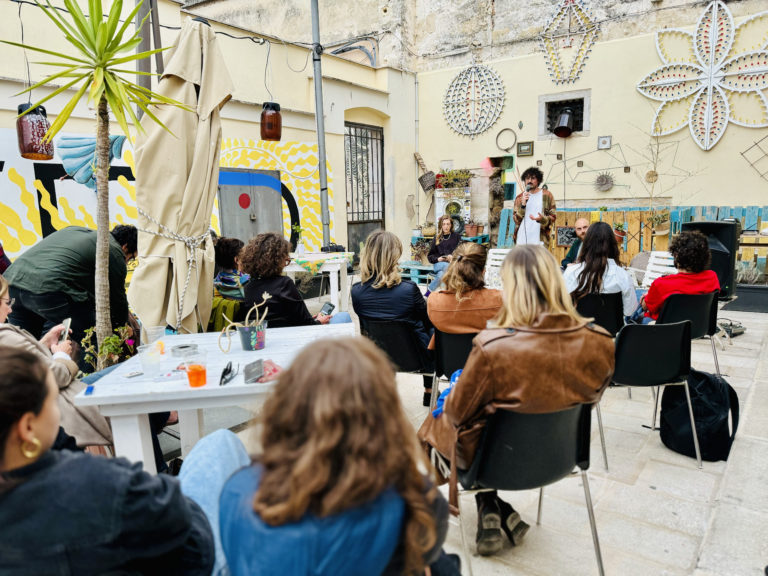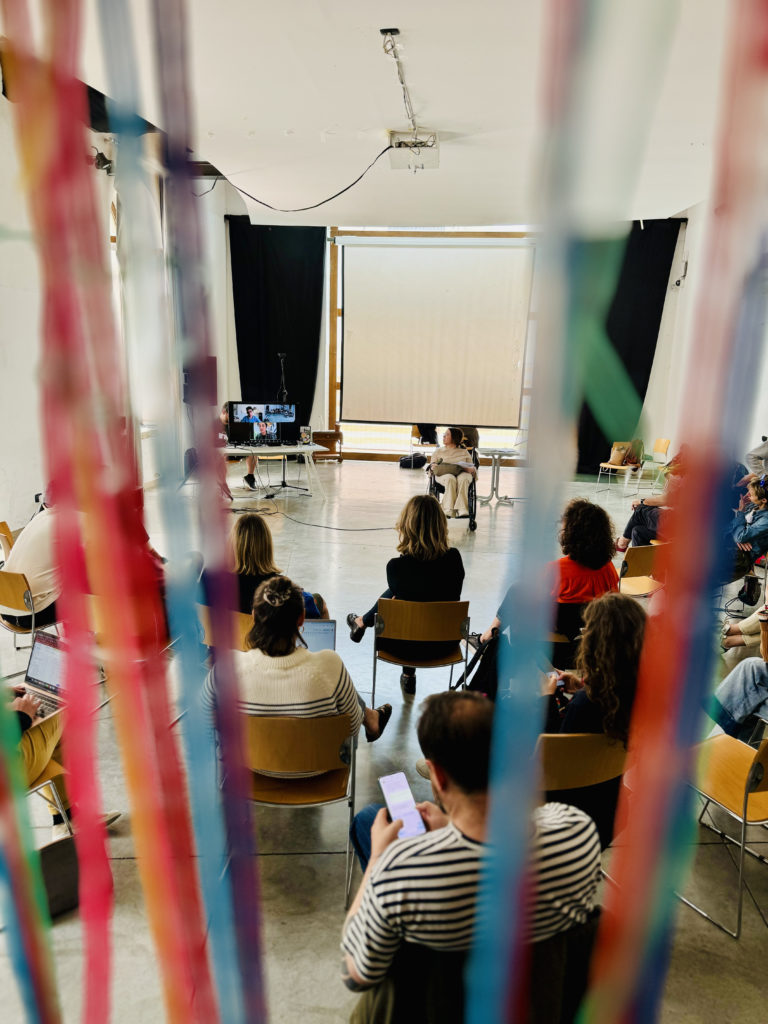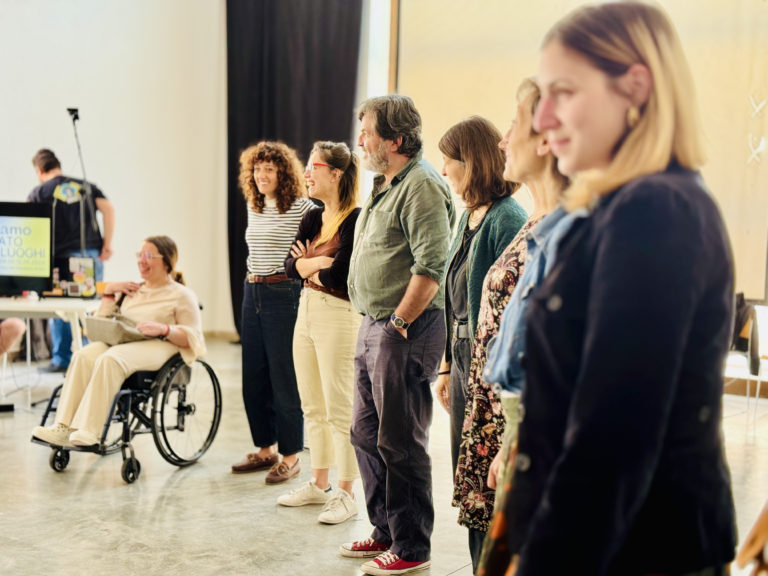Part. 2 of the series: Independent Cultural Spaces in Italy
Author: Matilde Bignotti
Once unheard of, culture-based urban regeneration has seen a significant transformation in Italy over the past decade. In the second of a three-part series, Matilde Bignotti explores along with Roberta Franceschinelli, president of Lo Stato dei Luoghi, how the rise of research, data, and best practices surrounding this grassroots movement has signified a shift toward recognising the role of community-driven spaces in revitalising urban areas. However, despite this progress, these spaces still struggle for legitimacy, as there is no formal policy framework to support their existence. Lo Stato dei Luoghi is working to bridge this gap by advocating for these spaces, pushing for public recognition, and fostering collaborative networks to sustain their impact.

Lo Stato dei Luoghi last General Assembly in Andria, at L'Officina San Domenico – © Laura Migliaccio
“Ten years ago, in Italy no one was talking about places involved in culture-based urban regeneration, whereas today we have plenty of research, data, and best practices are clear” says Roberta Franceschinelli, president of Lo Stato dei Luoghi network, as she guides me through the current state of the phenomenon. But then, revealing the actual state of the places, she adds: “Despite the amount of information, these places are still not recognised as an entity as there is no rule that legitimises their existence.”
For those who have not heard of it in the last ten years, culture-based urban regeneration is a grassroots, independent process capable of transforming an area and its community by adding value to existing physical, cultural, and social resources. Usually based in repurposed derelict buildings, these regenerative initiatives engage and activate the local community by offering innovative programmes of cultural events, interactive workshops, courses, and moments of exchange.
Matilde Bignotti: Before delving into the question about the recognition and impact of hybrid spaces, I’d like to know more about the origins of Lo Stato dei Luoghi network. What needs and demands led to its creation?
Roberta Franceschinelli: Lo Stato dei Luoghi (LSdL) is an independent association and, like the spaces it represents, it wasn’t born with the support of public institutions, but from a need felt at the grassroots level.
The genesis of LSdL can be traced back to a specific situation that illustrates the demands behind its creation. It all started with a complaint against Farm Cultural Park, an urban regeneration project that has been operating since 2010 in Favara, Sicily. The Municipality of Favara condemned some of the works of art that the Farm had installed in the old town centre and demanded the ‘restoration of the state of the place,’ despite the fact that the installations had previously been authorised by the town council. The founders of Farm Cultural Park, Florinda Saieva and Andrea Bartoli, reached out to me and other people involved in regenerative projects to ask for help in dealing with the situation. So we started a petition asking the council to withdraw the order. Over 5,000 signatures were collected within a few days and the case was brought into the spotlight. Thanks to this visibility, Florinda and Andrea were received by the Culture Cabinet, and the problem was quickly resolved.
The importance of this case goes beyond Favara, the petition was a cry for justice and respect for all cultural initiatives trampled underfoot by the administrations. The great response it generated confirmed that this case wasn’t an isolated one and that united we are louder. It was clear to us that independent cultural initiatives needed a space that would bring them all together, that would represent them all as one in the face of the many struggles that their heterogeneous and unstructured situation exposes them to. So we brought together different people and organisations working in the field of culture-based urban regeneration, from cultural centre managers to people working in foundations. We decided to name the network after the iconic threat mentioned in the Favara case, The State of the Place: Lo Stato dei Luoghi.

Lo Stato dei Luoghi last General Assembly in Andria, at L'Officina San Domenico – © Laura Migliaccio
The public administration still does not recognise the places that make culture-based urban regeneration possible, meaning that there are no policies dedicated to regulate and define hybrid spaces as legal entities. What are the barriers to this recognition?
RF: It would be interesting to put this question to the politicians who make the laws…
In my opinion, it is due to the essence of culture-based urban regeneration: it is a contemporary phenomenon, it’s ongoing and it’s constantly changing. There are multiple ways of doing culture-based urban regeneration and, as the name suggests, the places involved in the process are hybrid and make cultural innovation. The term innovation itself is quite complex as it brings to the table new perspectives and practices on cultural entrepreneurship and community management. For example, the source of economic sustainability of these spaces comes from a mix of funding opportunities which cannot be flattened to a single model of cultural enterprise.
Furthermore, the way these spaces impact welfare is also hard to simplify and grasp as it is generative: By actively engaging the community, hybrid spaces create social interaction and cohesion, people are empowered to get involved, to take agency, to create, and learn. This innovation is harder to grasp with numbers and statistics, it is generated throughout a long-term process that deals with the personal development of people and invests in the sphere of citizenship and participation in democratic life. It is certainly challenging to measure the change brought by culture-based urban regeneration processes as it gives value rather than economic revenue.
This leads us to another important limit to the recognition of hybrid spaces: the traditionalist and conservative approach of our country towards culture. In Italy, it’s harder to recognise the complex nature of these spaces because the concept of culture is still tied to the cultural industries, such as theatres, cinemas, and museums, as well as to tourism. The impact on the economy of these institutions is straightforward: employment rate, tickets, products created and sold are measurable values. On the other hand, hybrid spaces do not belong to ‘the industry’, they are mostly non-profit, operate on a volunteer base and the culture produced is dynamic and community-based. Their value, in profitable terms, emerges in a long-term perspective and social framework as it involves the growth, empowerment, and education of people as individuals and as a community. The blindness towards this value is probably another reason: policy makers do not recognise this phenomenon as relevant enough to put it on the agenda.
Nowadays, what is the state of hybrid spaces and urban regeneration in the Italian context?
RF: Well, culture-based urban regeneration initiatives have been a growing phenomenon for over 15 years and I believe that the ‘emerging’ phase of studying and understanding them is over. We are ready for the next step: these initiatives need to be actively supported by dedicated policies at the national level.
We’re in 2024, and just as theatres and museums exist and are recognised as actors in the cultural scene, hybrid cultural regenerated spaces also exist and produce culture. They therefore need specific policies and funding schemes. For the time being, their development still depends on the proactivity of the individual space-makers (the people who activate urban regeneration processes), and their relationship with their local council. Indeed, things can change from place to place as there is no legal framework that allows them to play by the same rules in different places.
It is also important to note that in Italy the concession of a site is always for a ridiculously short period of a few years. Other countries, such as France and Germany, have a 30-year concession system, which makes it possible to do what is still not possible here: plan for the long term and develop a stronger link with the territory.
It is true, however, that some things are changing. The ‘Third Sector Code’, established in 2017, has structured the very diverse landscape of non-profit organisations by introducing norms and regulations for associations. Since then, specific calls for proposals have been launched, encouraging the creation of new entities or the consolidation of existing ones. In addition, the General Directorate of Contemporary Creativity, a branch of the Ministry of Culture, has made it its mission to support cultural and creative enterprises, as well as urban regeneration initiatives. Their contributions include promoting research and offering grants and funding opportunities. For example, since 2017, they have provided additional funding to Culturability, an initiative launched by the Unipolis Foundation that supports cultural and social innovation projects. This year marks the fifth edition of their Creative Living Hub project, which focuses on urban regeneration in suburban and transitional areas. This attention and active involvement are crucial, but for meaningful change to occur, hybrid spaces need to be recognised by policymakers.

Lo Stato dei Luoghi last General Assembly in Andria, at L'Officina San Domenico – © Laura Migliaccio
Faced with all these challenges inherent to cultural regeneration spaces and the approach of public administration, how is Lo Stato dei Luoghi working to support, develop, and change the situation?
RF: We are active on several levels. Firstly, the network includes hundreds of independent cultural initiatives engaged in regenerative practices: non-profit associations, cooperatives, commercial organisations (S.r.l.), and individuals. We reflect and legitimise the heterogeneity of these hybrid realities, which would otherwise be lost in their complexity. By gathering such diverse experiences together, Lo Stato dei Luoghi enables an exchange of knowledge, best practices, and connections between them that enriches us all.
Then, as a network, we represent and advocate these initiatives to public administrations at local, regional, and national levels, as well as to donors and other institutions. We have built up a good reputation over the years, so administrations invite us to share our know-how by organising workshops and lectures during special events.
Municipalities that host hybrid spaces that are part of our network call on us as external stakeholders to share our expertise on urban regeneration practices. At the regional level, we are now working with the Puglia region to connect the cultural centres that are part of our network with Luoghi Comuni, a series of spaces that have been regenerated through a project initiated by the region itself.
Regarding government bodies, we are not in direct contact with who holds legislative power and policy makers… However, we have collaborated with the General Directorate of Contemporary Creativity. In collaboration with LSdL and IUAV, University of Venice, they have promoted a call aimed at non-profit organisations and community-based social enterprises which want to contribute to the public debate on the cultural regeneration of places. This project resulted in a recent publication: Ibridazioni.
Can you tell me more about Ibridazioni and highlight its impact on the current situation of hybrid spaces in the country?
RF: This publication, entitled Hybridisation - New policies for the urban regeneration of places, is the result of the open call (mentioned above) that brought together over 250 organisations working in the field and engaged them in a series of workshops and panels on key issues. This journey resulted in a series of recommendations on core urban regeneration issues such as medium- and long-term economic sustainability, project governance, impact assessment models, social and employment issues, and more. Making Hybridisation not only engaged us all in a process of sharing, questioning, and learning together, but also produced the first guidelines for urban regeneration practice. Thanks to an interdisciplinary collaboration, we were able for the first time to take stock of the current situation, open up new scenarios, and share some practical recommendations useful for public administrations, hybrid space creators, and donors.
In terms of impact, the publication is generating a great response. We have been invited to present it and to look at some specific recommendations made by municipalities and regions. These are precious opportunities to share practical knowledge, to make the phenomenon more widely known, to reach people involved in social and cultural projects and, above all, to involve decision-makers.
Published on October 15th, 2024
About the author:
Matilde Bignotti is an Italian freelance event curator, writer, and coordinator of community-based projects. In the Netherlands, Matilde has collaborated with institutions such as Centraal Museum, Utrecht University and DeVoorkamer in writing and facilitating programs that generate inclusivity through creativity and co-curation.